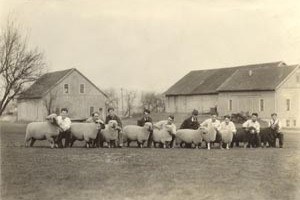
A group of sheep, ready for exhibition, photographed in front of the Old East Barns around 1930.
At one time, sheep were an important livestock species in Pennsylvania. Large flocks of fine-wooled sheep could be found in the southwestern part of the state and medium-wool mutton breeds in the southeast.
Because of the pastoral agriculture practiced and the ability of sheep to utilize forage, they were a valuable livestock commodity. Wool from Merino sheep was in demand; it could be held in storage for a long period of time and could be produced economically. It is reported that more than one million sheep grazed the hills of the Commonwealth in 1900.
In the early years, the sheep owned by the University were almost entirely Merinos, a fine-wool breed that produced outstanding fleeces, but were of little value for lamb or mutton production. In 1920, W. H. Tomhave and C. W. McDonald authored Agricultural Experiment Station Bulletin No. 163, entitled Cross Breeding Delaine Merino Ewes with Pure Bred Mutton Rams.
One of the objectives of the experiment was to "grade up a flock to mutton-type conformation." Although fine-wooled sheep had been the predominant type for many years, the emphasis in Pennsylvania sheep production was changing. Sheep that were faster growing, more efficient, and meatier were being sought. Merinos became instrumental in the production of foundation ewes for crossbreeding to mutton-type rams, resulting in both desirable market lambs and hothouse lambs for specialty markets. Research along these lines, plus studies in wool production and fiber diameter, continued for some time.
When Dr. William L. Henning joined the faculty, a gradual change in breed emphasis took place. Purebred flocks of Southdowns, Shropshires, and Horned Dorsets were added. Later Hampshires and Cheviots became part of the purebred breeding effort. In 1960 the five breeds named, plus one representative of the Merino breed, comprised the sheep inventory. In the early 1950s, Carroll Shaffner, a well-known fitter and showman, was hired as shepherd and flock manager and was charged with bringing the flocks to prominence. Penn State soon gained recognition as a major contender in purebred shows and sales and as a producer of quality seedstock. Rams imported from New Zealand were used in the Southdown flock, bringing about significant changes in size and productivity. Shropshires were selected for increased size and more open faces. The other breeds were also improved by judicious selection and breeding practices. Much of this improvement was the result of the Livestock Improvement Act of 1949 that provided funds for livestock purchases.
Late in the 1950s, the Horned Dorsets were replaced with Polled Dorsets, the only breed remaining at Penn State today. The Southdown, Shropshire, and Cheviot flocks were dispersed at the height of their popularity and value. Hampshires were replaced with a high quality Suffolk flock. For several years, Polled Dorsets and Suffolks were maintained, each flock numbering approximately 40 ewes. The small flock size made it difficult to follow a meaningful breeding program, and the decision to concentrate on only one breed was made. Dick Kuzemchak succeeded Shaffner as shepherd and has continued the tradition of good shepherding and high production. The purebred flocks have made important contributions to the genetic composition of many flocks in the United States through the rams and ewes that have been produced and sold. In addition, outstanding classroom material has always been available.
The "old" sheep barn, located where the Henning Building now stands, was replaced in 1961 with the current Beef and Sheep Center. Student living quarters, offices, research areas, as well as housing for animals, are included in this facility. Numerous metabolic and related studies have been conducted in the air conditioned "metabolism room." Crossbreeding, creep feeding, milk production, estrus synchronization, and pasture trials have been ongoing research efforts through the years.
Professor Harry Havner DVM was the first faculty member appointed to carry out extension work with livestock other than dairy. He started work in 1911 and resigned in 1929 to go into commercial work. In 1918, W. B. "Bill" Connell was hired. He worked primarily with beef and sheep production until his retirement in 1951. Connell was responsible for starting the "wool pools" that became an important step in the marketing of wool in the state. Wool pools were usually held in June, and most of the early animal husbandry specialists spent a good portion of the month grading wool. Selection procedures for traits important to livestock were largely based on the physical characteristics of animals exhibited at county fairs and field days. These event demonstrations occupied a considerable amount of a specialist's time during the summer and early fall show season.
Beginning in 1956, Ben Morgan provided leadership and expertise for an excellent extension program. His shearing schools and barn meetings were very valuable to sheep producers throughout the state. Annual field days were always well attended; talks, demonstrations, and a "lamb stew" luncheon drew sheep enthusiasts to the campus. The Department hosted a National Hampshire Sheep Type Conference in 1971 that brought Hampshire breeders from a wide area. Short Courses and Correspondence Courses emphasizing the "how to" of sheep production have also been a part of the history of sheep at Penn State.
Author: Tom Merritt, Professor of Animal Science
Department of Animal Science
Address
439 Shortlidge Road, Room 109University Park, PA 16802
- Email AskDAS@psu.edu
- Office 814-865-1362
Department of Animal Science
Address
439 Shortlidge Road, Room 109University Park, PA 16802
- Email AskDAS@psu.edu
- Office 814-865-1362

